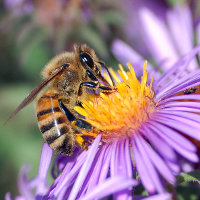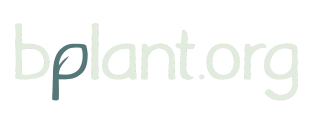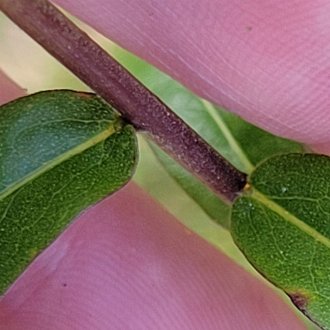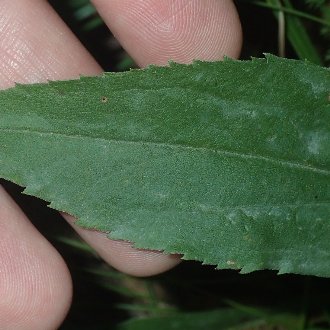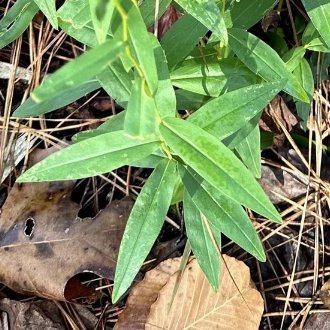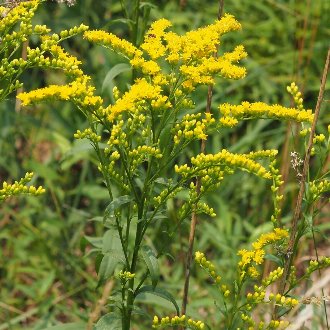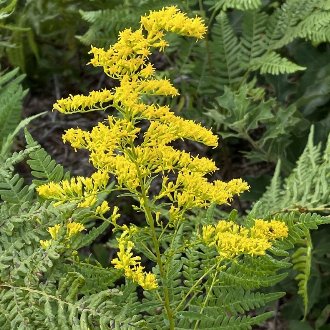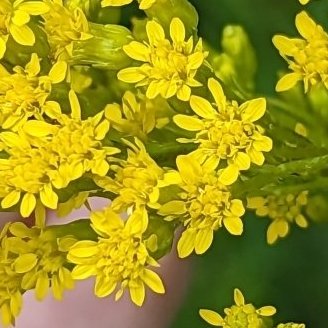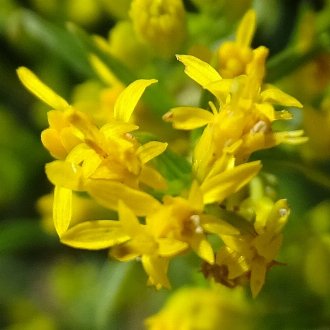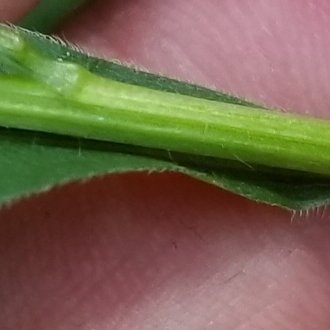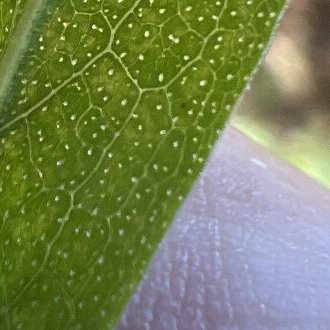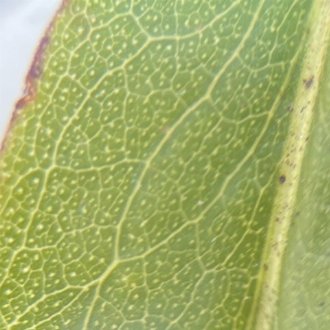Early Goldenrod vs Sweet Goldenrod
These two goldenrods are frequently confused in their small range of overlap. Both bloom early, have smooth leaves, upper leaves that lack serrations, and grow in dry habitats, often those with sandy, acidic soil. They are easily distinguished by inflorescence shape, floret count per flowerhead, leaf bases, and serrations on lower leaves. S. juncea ranges farther north, prefers more nutrient-rich, less-acidic soil, and is more likely in anthropogenic or human-disturbed habitats. S. odora ranges farther south and is strictly limited to sites with acidic, nutrient-poor soils, but less likely on sites disturbed or altered by humans.
Early Goldenrod (Solidago juncea) | Sweet Goldenrod (Solidago odora) |
A perennial, usually among the earliest blooming of the goldenrods. | A clumping perennial of nutrient-poor, acidic soils, with distinctive anise-scented leaves. |
Leaves higher up on the stem taper at their bases and meet the stem at a narrower angle. Photo © Sandy Wolkenberg, CC BY 4.0. | Leaves higher up on the stem have rounded bases. Photo © Matt Pelikan, CC BY 4.0. |
Lower leaves on the stem, and basal leaves, are sharply serrated. Photo © John Baur, CC BY 4.0. | None of the leaves are serrated; even lower leaves have smooth margins. Photo © Chuck Wilson, Public Domain. |
Inflorescence branches often tend to arch or curve downward. Branches are more equal in length, and spaced closer together along the central stem, and the inflorescence to spans a shorter vertical distance. Photo © Kevin Faccenda, CC BY 4.0. | Inflorescence branches are more horizontal, parallel, and unequal in length. Branches are spaced slightly farther apart along the central stem, and the inflorescence spans a longer vertical distance. Photo © John P, CC BY 4.0. |
Flowerheads have many more florets: 7-12 ray florets and 8-15 disc florets. Photo © Skyler Principe, CC BY 4.0. | Flowerheads have fewer florets: 3-4 ray florets (rarely to 6) and 3-5 disc florets. Photo © Sandra Keller, CC BY 4.0. |
Leaf margins are ciliate (covered in tiny hairs) when viewed very closely. Photo © Daniel McClosky, CC BY 4.0. | Leaf margins are hairless. Photo © Alan Weakley, Public Domain. |
Leaf surfaces do not have glands. Photo © Katherine Baird, CC BY 4.0. | Leaf surfaces are dotted by tiny glands. Photo © Dan Wilder, Public Domain. |
Stems are usually completely hairless, occasionally having sparse hair in the inflorescence. Photo © John Baur, CC BY 4.0. | Stems may appear hairless from a distance, but usually have hairs arranged in lines, at least in the inflorescence and near leaf bases, sometimes throughout. Photo © Becky Dill, Public Domain. |
Plants are often (not always) rhizomatous, forming vegetative colonies with multiple clumps connected by underground stems, often as many as 10 upright stems, occasionally more. Different plants in a clonal colony may be spaced rather far apart. Photo © Scott Harris, CC BY 4.0. | Plants are not rhizomatous, instead forming a clump with a branching caudex, clumps usually having 1-5 stems, rarely more. Stems of a clump originate from a single point. Photo © Becky Dill, Public Domain. |
Additional Notes
The overlap between these two species seems to be increasing due to anthropogenic influences, typically through S. juncea moving into habitats where only S. odora was previously found. One mechanism for such colonization is the building of roads and the placing of gravel for road beds. Gravel is often made of rocks rich in calcium and magnesium, where it weathers into higher-pH soil adjacent to the roads. Although both species prefer acidic soil, S. odora is more strictly limited to lower pH levels. The newly-created spots with increased disturbance from roadside maintenance, and higher soil pH, are colonized by S. juncea, whereas S. odora remains limited to sites farther from the road where soils are still more acidic and there is less disturbance.References & External Resources
These short lists show only links helpful for ID. For a complete list of references and resources also covering other aspects of ecology, visit the links section of the full article on each plant, which is the first entry here.

